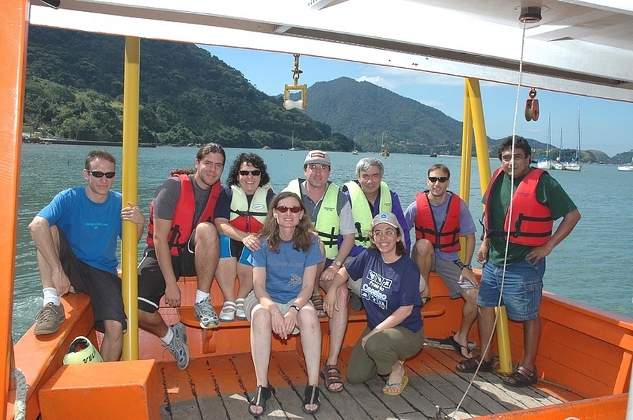Brazil – National Institute for Space Research (INPE)
Dr. Robert Frouin of Scripps Institution of Oceanography (USA), with the help of experts from the international ocean-colour community (incuding Dr. Greg Mitchell from Scripps and Dr. Vivian Lutz from INIDEP, Argentina, Prof. Ichio Asanuma from Tokyo University and Dr. Ewa Kwiatkowska from NASA), provided training to 16 trainees from Mexico, Peru, Colombia Venezuela, Argentina, and various Brazilian institutions, in the use of remotely sensed ocean-colour data as a tool for analysing the marine ecosystem. The training course also endeavoured to further develop the ANTARES project, an integrated network of long-term time series stations in Central and South America whose main goal is to detect and understand the impact of climate change and human activities, and to provide the scientific basis for ecosystem definition and management.
The training included two major group activities, with formal lectures, theoretical work, laboratory measurements, field experiment, and data analysis. All the major aspects of ocean-colour remote sensing were covered, from fundamental principles to modeling, inversion, instrumentation, and measurements. The trainees were divided into three teams composed of biologists and physicists. Each team had to produce reports and make presentations about the work accomplished. The format allowed the trainees to learn and familiarize themselves with various aspects of ocean colour remote sensing, to apply and deal practically with the theoretical concepts introduced in the formal lectures, to interact among themselves, and to develop strategies for their individual research in biological oceanography and remote sensing. During the course, SIO journals, serials, and other materials were accessible electronically via a proxy server, which proved to be a valuable resource for the trainees.
The first activity focused on ocean colour, with lectures on processes affecting marine reflectance, modeling of marine reflectance, measurement of marine reflectance, and inversion of marine reflectance. Other lectures related to optics of particulate and soluble material in water, measurement of ocean optical properties and regional differentiation, and phytoplankton photosynthetic physiology and measurement of photosynthesis. Drs. Greg Mitchell from SIO and Vivian Lutz from INIDEP joined Dr. Robert Frouin in giving the lectures. Hands-on activities included laboratory work at the Oceanographic Institute of the University of São Paulo, and field work at the marine station in Ubatuba. Equipment purchased under the visiting professorship programme included a UV spectrophotometer and a Quantum PAR sensor. The trainees were initiated in the use of above-water radiometry, fluorometry, and spectrophotometry, including measurement protocols and data processing. Student projects included the collection of water samples and radiometric data from coastal waters off Ubatuba, which were then processed and evaluated using the OC4V4 algorithm. The trainees each wrote a report about the theoretical and experimental work accomplished and presented their results.
A second session focused on ocean colour remote sensing from space, with lectures on atmospheric correction schemes, inverse modeling, satellite ocean-colour sensors, calibration of ocean-colour sensors, evaluation of ocean-colour products, and modeling of primary production from space. The lectures were complemented by practical sessions about SeaDAS, ocean-colour programming, and primary production modeling. Prof. Ichio Asanuma from Tokyo University and Dr. Ewa Kwiatkowska from NASA joined Dr. Robert Frouin in giving the lectures and conducting the practical sessions.
Dr. Robert Frouin also traveled to Mar Del Plata, Argentina, to demonstrate and donate a SIMBADA radiometer to INIDEP for routine measurements at their ANTARES time series station, and to train INIDEP students and scientists in the use of the instrumentation. After the training course at INPE Dr. Robert Frouin traveled to São José Dos Campos and Ubatuba to test newly acquired optical instrumentation and to refine measurement protocols, and to participate in the October 2006 ANTARES cruise in Ubatuba.
Brazil Visiting Fellowship report here
Participants
- Rene Ayala Campos (Venezuela)
- Melissa Carvalho (Brazil)
- Sergio Cerdeira-Estrada (Mexico)
- David Correa Chilón (Peru)
- Ana Inés Dogliotti (Argentina)
- Cesar Fernando Garcia Llano (Colombia)
- Adriana Gisel Gonzalez Silvera (Mexico)
- Eduardo Miranda de Souza (Brazil)
- Eduardo Negri De Oliveira (Brazil)
- Mauricio Noernberg (Brazil)
- Mayza Pompeu (Brazil)
- Conrado Rudorff (United States)
- Frederico Rudorff (Brazil)
- Eduardo Martin Santamariadelangel (Mexico)
- Ezzat Selim Chalhoub (Brazil)
- Márcio Silva De Souza (Brazil)

